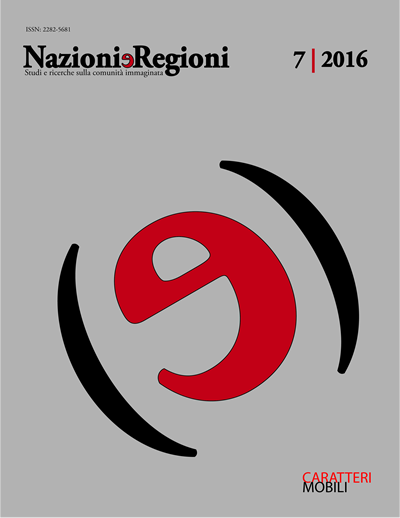Il processo di abbattimento e di ripristino delle frontiere in Europa
DOI:
https://doi.org/10.15162/2282-5681/1505Riferimenti bibliografici
Besier G. (2014), «Boundaries between Ourselves and Others: The Role of Prejudice and Stereo-types in General with Specific Reference to Border Regions», in Stokłosa K. – Besier G. (eds.), European Border Regions in Comparison: Overcoming Nationalistic Aspects or Re-Nationalization?, Routledge, London-New York, pp. 307-320.
Boehmer Ch. R. – Peña S. (2012), «The Determinants of Open and Closed Borders», Journal of Bor-derlands Studies, n. 27, pp. 273-285.
Cuttitta P. (2012), «Das europäische Grenzregime: Dynamiken und Wechselwirkungen», in Hess S. – Kasparek B. (eds.), Grenzregime. Diskurse. Praktiken. Institutionen in Europa, Assoziation A, Berlin–Hamburg, pp. 23-40.
Hattenberg D. (2007), «Constitutional Aspects of Transborder Co-operation», in Langer J. (ed.), Eu-roregions – The Alps-Adriatic Context, Peter Lang, Frankfurt am Main, pp. 81-95.
Hess S. – Tsianos V. (2012), «Ethnographische Grenzregimeanalyse als Methodologie der Autono-mie der Migration», in Hess S. – Kasparek B. (eds.), Grenzregime. Diskurse. Praktiken. Institu-tionen in Europa, Assoziation A, Berlin-Hamburg, pp. 243-264.
Ilyukha O., (2013), «The Socio-Cultural Landscape of the Soviet-Finnish Borderland of the 1930s as Seen Through Autobiographic Childhood Stories», in Stokłosa K. – Besier G. (eds.), Euro-pean Border Regions in Comparison: Overcoming Nationalistic Aspects or Re-Nationalization?, Routledge, New York-London, pp. 221-235.
Jagetić Andersen D. – Klatt M. – Sandberg M. (eds.) (2012), The Border Multiple: The Practicing of Bor-ders between Public Policy and Everyday Life in a Re-scaling Europe, Ashgate, Aldershot-Burlington.
Jańczak J. (2013), Border Twin Towns in Europe. Cross-border Cooperation at a Local Level, Logos, Berlin.
Kennard A. (2010), Old Cultures, New Institutions. Around the New Eastern Border of the European Union, LIT, Berlin.
Kolossov V. (2006), «Theoretical Limology: New Analytical Approaches», in Lundén T. (ed.), Cross-ing the Border. Boundary relations in a changing Europe, Förlags ab Gondolin, Gdansk, pp. 15–35.
Kurki T. – Laurén K. (2012), «Borders and Life-Stories», Folklore, n. 52, .
Lemberg-Pedersen M. (2012), «Forcing Flows of Migrants: European Externalization and Border-induced Displacement», in Jagetić Andersen D., Klatt M., – Sandberg M. (eds.), The Border Multiple: The Practicing of Borders between Public Policy and Everyday Life in a Re-scaling Europe, Ash-gate, Aldershot-Burlington, pp. 35-53.
Liebert U. (2012), «The Emergence of a European Identity», in Zimmermann H. – Dür A. (eds.), Key Controversies in European Integration, Palgrave Macmillan, Basingstoke-New York, pp. 96-103.
Marung S. (2013), Die wandernde Grenze. Die EU, Polen und der Wandel politischer Räume, 1990–2010, Vandenhoeck & Ruprecht, Göttingen.
McCall C. (2014), The European Union and Peacebuilding. The Cross-Border Dimension, Palgrave Macmil-lan, Basingstoke.
Moraczewska A. (2014), «A Secure Border or a Border at Risk?», in Moraczewska A. – Janicki W. (eds.), Border Conflicts in the Contemporary World, Maria Curie-Skłodowska University Press, Lu-blin, pp. 71-80.
Morzycki-Markowski M. (2010), «How People Crossed Borders in Socialism. The Polish Case», in Borodziej B. – Kochanowski J. – von Puttkamer J. (eds.), “Schleichwege”. Inoffizielle Begegnungen sozialistischer Staatsbürger zwischen 1956 und 1989, Köln-Weimar-Wien. pp. 55-66.
Opiłowska E. (2014), «The Europeanization of the German-Polish Borderlands», in Stokłosa K. –Besier G. (eds.), European Border Regions in Comparison: Overcoming Nationalistic Aspects or Re-Nationalization?, Routledge, New York-London, pp. 275–285.
Pasi P. (2007), «Euroregions as Micro-Models of European Integration», in Langer J. (ed.), Euro-regions – The Alps-Adriatic Context, Peter Lang, Frankfurt am Main, pp. 73-79.
Polese A. (2012), «Who Has the Right to Forbid and Who to Trade? Making Sense of Illegality on the Polish-Ukrainian Border», in Bruns B. – Miggelbrink J. (eds.), Subverting Borders. Doing Re-search on Smuggling and Small-Scale Trade, VS Verlag für Sozialwissenschaften, Wiesbaden, pp 21-38.
Schönwald A. (2013), «Identities and Stereotypes in Cross-Border Regions», in Lechevalier A. – Wielgohs J. (eds.), Borders and Border Regions in Europe. Changes, Challenges and Chances, Tran-script-Verlag, Bielefeld, pp. 113-127.
Sendhardt B. (2013), «Border Types and Bordering Processes. A Theoretical Approach to the EU/Polish-Ukrainian Border as a Multi-dimensional Phenomenon», in Lechevalier A. –Wielgohs J. (eds.), Borders and Border Regions in Europe. Changes, Challenges and Chances, Tran-script-Verlag, Bielefeld, pp. 21-43.
Smolarkiewicz E. (2008), «Tożsamość na pograniczach», in Kurcz Z. (ed.), Polskie pogranicza w pro-cesie przemian Tom I, WWSZiP, Wałbrzych, pp. 146-148.
Stokłosa K. (2003), Grenzstädte in Ostmitteleuropa. Guben – Gubin 1945–1995, Berliner Wissen-schaftsverlag, Berlin.
Stokłosa K. (2006), «Two Sides of the Border and One Regional Identity: The Identity Problem in the German-Polish and Ukrainian-Slovak Border Regions», in Lundén T. (ed.), Crossing the Bor-der. Boundary Relations in a Changing Europe, Förlags ab Gondolin, Gdansk, pp. 117-133.
Stokłosa K. (2007), «Opportunities and Problems of Euroregions along the Polish-German Border», in Langer J. (ed.), Euroregions – The Alps-Adriatic Context, Peter Lang, Frankfurt am Main, pp. 233-242.
Stokłosa K. (2012), «Neighborhood Relations on the Polish Borders: The Example of the Polish-German, Polish-Ukrainian and Polish-Russian Border Regions», Journal of Borderlands Studies, n. 27, pp. 245-255.
Stokłosa K. (2014), «The Border in the Narratives of the Inhabitants of the German-Polish Border Region», in Stokłosa K. – Besier G. (eds.), European Border Regions in Comparison: Overcoming Nationalistic Aspects or Re-Nationalization?, Routledge, New York-London, pp. 257-274.
Stokłosa K. (2013), «Conflict and Co-operation: Poland’s Border Regions in the Cold War and Af-ter», Österreichische Zeitschrift für Politikwissenschaft (ÖZP), n. 42, pp. 69-77.
Stokłosa K. (2015), «Border Regions as Laboratories of European Integration», in Opiłowska E. –Roose J. (eds.), Microcosm of European Integration. The German-Polish Border Regions in Transfor-mation, Nomos, Baden-Baden, pp. 28-43.
Useinov N. (2014), «Crimea: from Annexation to Annexation, or How History Has Come Full Cir-cle», in Bachmann K. – Lyubashenko I. (eds.), The Maidan Uprising, Separatism and Foreign Inter-vention. Ukraine’s Complex Transition, Peter Lang, Frankfurt am Main, pp. 207-226.
Vitale A. (2014), «The Impact of the EU Integration Process on the Border Disputes between Rus-sia and Estonia», in Moraczewska A. – Janicki W. (eds.), Border Conflicts in the Contemporary World, Maria Curie-Skłodowska University Press, Lublin, pp. 214-225.
White J. (2012), «A Common European Identity Is an Illusion», in Zimmermann H. – Dür A. (eds.), Key Controversies in European Integration, Palgrave Macmillan, Basingstoke-New York, pp. 103-111.
Zimmermann H. – Dür A. (2012), «Can There Be a Common European Identity?», in Zimmermann H. – Dür A. (eds.), Key Controversies in European Integration, Palgrave Macmillan, Basingstoke-New York, p. 95.
Zochowska Despiney B. A. (2013), «Euroregions. Emerging New Forms of Cross-Border Coopera-tion», in Lechevalier A. – Wielgohs J. (eds.), Borders and Border Regions in Europe. Changes, Chal-lenges and Chances, Transcript-Verlag, Bielefeld, pp. 71-94.
Downloads
Pubblicato
Fascicolo
Sezione
Licenza
Nazioni e regioni è una rivista open access che applica la licenza Creative Commons CC BY-NC-ND 4.0 a tutti i contenuti pubblicati.
Nazioni e regioni is an open-access journal that applies the Creative Commons CC BY-NC-ND 4.0 licence to all published contents.







